Why specification matters more than ever
- Specify & Build
- 5 days ago
- 2 min read
With the introduction of the Building Safety Act and gateway approval system, the notion of swapping out specified products has almost entirely been phased out. James Moore, National Sales Manager for Hardie Panel from James Hardie considers the importance of making the right decisions at the specification stage.
The Building Safety Act and subsequent gateway approval system has reshaped the landscape of building design, construction and compliance. Across new and existing buildings, the safety regime has introduced additional responsibilities, raised new considerations and changed communication throughout the development chain.
Among the most significant and immediate changes has been the increased rigidity of product specification. What was once a relatively flexible part of the design and build process is now tightly controlled and, in many cases, swapping out is no longer an option. Getting it right from the start has never been more important.
Focus on safety and compliance
The gateway approval system was established to place greater scrutiny on building safety throughout a project’s lifecycle, and especially during the early design and planning stages. Each gateway acts as a hard stop, requiring evidence that building safety has been properly considered and integrated into the design before moving forward. For those with responsibility for specifying products, every decision must be backed by rigorous testing, performance data and long-term assurance of compliance, particularly when it comes to critical elements such as fire safety.
This means that once a product is specified and approved at a gateway stage, it effectively becomes locked into the project. Swapping it out for a similar or cheaper alternative – previously common at site level – can delay the project significantly and trigger the need for fresh approvals from the relevant authorities. And with so much focus on Gateway 2 delays, where around 800 projects were stalled at the start of 2025 according to a Freedom of Information request by consultant Project4, it’s easy to see the impact.
In cladding, for example, where A2 fire rating under the BS EN 13501-1 standard is the minimum standard for ‘Higher Risk Buildings’ and ‘Relevant Buildings’ under the Building Safety Act, swapping out for an inferior product is not an option. What was once seen as smart value engineering may now compromise compliance, hampertimelines, and even risk liability. It’s more important than ever to ensure the right products are specified from day one.
Meeting stakeholders’ needs
Selecting the right building materials has always been a balancing act. For quantity surveyors, the pressure is on to deliver compliant solutions that stand up to regulatory scrutiny without compromising financial viability. Specifying a product with the correct fire rating classification is a necessary starting point, but it also means working with manufacturers that can provide robust technical data, in the correct format, to support seamless approvals through the gateway system and reduce the risk of costly rework or re-approval.
However, this can’t come at the cost of installation speed and efficiency for contractors. For many years, it was common for contractors to simply swap out the specification for ‘what they know’. With stringent approvals now in place, specifiers must choose products that are easy to install and meet quantity surveyors’ requirements.
Look for key installation features that can reduce time and labour on site, while also maintaining compliance. Hardie Panel fibre cement façade panels from James Hardie, for example, have been developed alongside a range of accessories for easy installation, providing a reliable system that can be used with most standard fixing systems. For the developer, materials must be fire resistant, weather durable and low maintenance. Products that offer long lifespans, low environmental impact, and excellent aesthetic qualities will boost satisfaction and help future-proof the development.
We believe this new era of regulation is an opportunity to elevate the industry. Making informed, conscious decisions at the specification stage can ensure smoother approvals, higher quality builds, and greater peace of mind for all involved. This is not just about avoiding the delays and costs associated with product swaps, it’s about building better, safer and more resilient buildings.
.png)































































.png)

